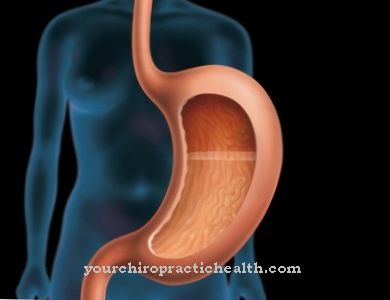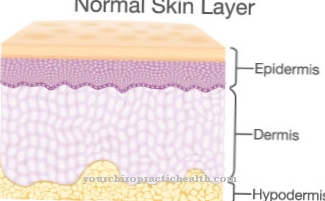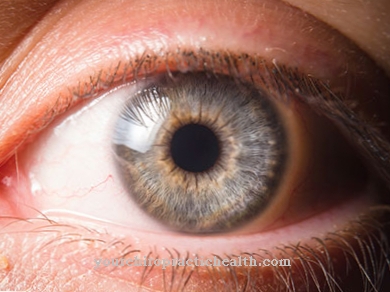Many physical diseases are associated with externally visible changes in the natural anatomical structure of the skin, bones or soft tissues. This also applies to the so-called Drumstick finger (also drumstick fingers), which are caused by a special blood disease.
What is a drumstick finger?
The Drumstick finger are a clear indication of a disease that is associated with chronic hypoxemia. These diseases are characterized by an insufficient supply of oxygen to the blood. As a result, thickenings form on the end members of the fingers, which not only encompass the bones but also various soft tissue parts.
The drumstick fingers are also called in medical professions Digitus hippocraticus or in the colloquial expression as Piston finger designated. In most causal diseases, the conspicuous drumstick fingers are accompanied by so-called watch glass fingernails.
causes
The causes of the bloated Drumstick finger are currently clearly proven. All of these diseases are characterized by hypoxemia. These diseases affect either the lungs or the heart and contribute to the drumstick fingers.
An emphysema of the lungs, tumors of the bronchi, a chronic obstructive disease of the lungs and acute interstitial pneumonia are responsible for an insufficient supply of oxygen in the blood and in the tissue, so that the drumstick fingers form.
The heart is also involved in providing oxygen to the organism. A congenital heart defect with a reduced pumping capacity of the heart muscle, a pulmonary-related high blood pressure and endocarditis can also result in drumstick fingers.
Diseases of the digestive system such as a loss of function of the liver, ulcerative colitis and Crohn's disease affect the drumstick fingers equally. Drumstick fingers can also occur with cystic fibrosis.
Symptoms, ailments & signs
Drumstick fingers are characterized by a typical appearance. The symptoms consist mainly of swollen fingers. The soft tissue changes are primarily due to newly formed capillaries. Drumstick fingers do not cause any discomfort, are therefore painless and do not hinder the movement of the fingers.
Occasionally, numbness can occur, but this is more likely due to causal diseases. The fingers appear noticeably thick, which makes the symptom quickly noticeable to the person concerned. Sometimes the fingers are discolored bluish or look puffy pink. Drumstick fingers are often associated with the so-called watch glass nails.
The changes in the fingers are themselves a symptom of various diseases. In almost all cases, they are triggered by a lack of oxygen in the tissue, which in turn can be traced back to lung or heart problems. In rare cases, the drumstick fingers appear on one side only, which can be attributed to an aneurysm, inflammation or certain types of tumor.
The other symptoms of drumstick fingers depend on the underlying diseases. They include, for example, breathing problems, cardiac arrhythmias, general weakness, circulatory problems and muscle weakness. The so-called piston fingers are generally considered to be an easily recognizable and serious symptom. They almost always have a serious cause that needs treatment.
Diagnosis & course
Become Drumstick finger visible, a far-reaching diagnosis is necessary if the anamnesis does not provide sufficiently well-founded knowledge. The diagnosis of drumstick fingers refers to the determination of special laboratory values of the blood and serum, x-rays, an echocardiography, the control of the lung function, an examination of the bronchi, a so-called sputum diagnosis and the examination of the digestive tract.
It is characteristic of the course or the pathogenesis of the drumstick fingers that the lack of oxygen in the blood and thus in the tissue leads to a physical reaction which leads to the thickened phalanges of the drumstick fingers. The undersupply of oxygen contributes to an increase in the volume of bone in the fingers. This is intensified in the drumstick fingers by an additional swelling.
The fingertips are areas in which the tissue is subject to permanent stress. In order to be able to comply with this, an additional bone tissue builds up, which is represented by the strange-looking drumstick fingers. Another explanation of how the drumstick fingers develop is based on the fact that hypoxia stimulates the production of a special growth substance. This substance helps to accelerate the formation of new capillaries in order to achieve a better oxygen supply to the tissue.
The drumstick fingers are created by more capillaries and an increase in collagenous connective tissue on the fingertips. As a result of these processes, the phalanxes of the fingers thicken and the watch glass nails can also develop as accompanying symptoms of the diseases shown. Usually drumstick fingers are coupled with cyanosis (bluish discoloration of the skin and mucous membranes).
When should you go to the doctor?
In the case of drumstick fingers, a doctor should be consulted in any case. Even if the complaints may not lead to restrictions in everyday life for the patient, they usually always point to diseases of the heart or the lungs and must therefore be examined and treated in every case. If the drumstick fingers are not treated, the patient can, in the worst case, die of heart problems or lung problems.
Therefore, in the event of permanent swelling of the fingers that occurs for no particular reason, always consult a doctor. The blue color of the fingers or extremities can also indicate problems with the heart or lungs. A medical professional should investigate these symptoms immediately. If there is difficulty in breathing or a stinging in the chest, the person concerned must call an ambulance or go to the hospital directly. Breathlessness or a heart attack can still lead to unconsciousness. In the worst case, the drumstick fingers or the underlying disease can lead to the patient's death.
Complications
Because of the drumstick fingers, those affected suffer from a number of different complaints. In most cases, the fingers themselves are significantly enlarged and swollen, which primarily results in reduced aesthetics.
Many patients feel uncomfortable with it and suffer from reduced self-esteem or from inferiority complexes. Furthermore, the entire hand can also be thickened, so that there can be significant restrictions in normal everyday activities. The drumstick fingers usually occur in connection with complaints of the heart or the circulatory system, so that the patients are always dependent on an examination.
In the worst case, heart problems remain undetected, resulting in the patient's death. Pain is also not uncommon with the drumstick fingers and has a negative effect on everyday life and the patient's quality of life. Treatment of this disease is carried out depending on the underlying disease.
For this reason, no general predictions can be made about the further course of events. However, if the underlying disease is successfully treated, the drumstick fingers will also be healed. The patient's life expectancy may also be reduced.
Treatment & Therapy
On the subject of treatment of the Drumstick fingers there is only the indication that the previous illnesses must be recognized and treated. If this leads to a better supply of oxygen in the tissues, the drumstick fingers disappear by themselves. When treating drumstick fingers, a quick diagnosis and prompt and efficient treatment of the lungs, heart, liver, stomach or Crohn's disease are necessary.
prevention
Around Drumstick fingers To prevent this, the underlying diseases must be avoided. The patients cannot have any direct influence on the prophylaxis.
A prevention that does not directly affect the development of drumstick fingers is an influenza vaccination. In addition, if there is a likelihood of developing drumstick fingers and watch glass nails, you should avoid nicotine consumption.
The oxygen distribution in the blood, which is already restricted by existing diseases, must not be additionally stressed by nicotine. This can prevent the formation of drumstick fingers.
Aftercare
Drumstick fingers return to their normal shape as soon as the underlying complaints are treated. The process takes several weeks to months, depending on the severity of the cause. Such causes are always an organic disease. After successful therapy, regular checks prevent the symptoms from recurring.
During the basic therapy, the attending physician defines periods for the control. Bronchoscopies, echocariographies, and other examinations are repeated about every three months, or every six months for minor symptoms. This is the only way to prevent recurrence including the other complaints or to eliminate them in good time. If drumstick fingers occur again, it is important to act quickly.
Because a flare-up of old symptoms leads to a repetition of the symptoms. Regular follow-up care against drumstick fingers requires discipline. However, the possible causes are worth every effort. After all, the change in the hands indicates far-reaching health problems. The causes and symptoms can only be resolved with medical help.
In the long term, adhering to medically prescribed diets and nutritional instructions helps prevent the re-development of drumstick fingers. Cancerous changes predominantly lead to these phenomena. Those affected still require an examination for intestinal problems. These can be a consequence of previously treated complaints in follow-up care.
You can do that yourself
In the case of drumstick fingers, it is a phenomenon that reduces the oxygen content in the blood. This causes deformation of the fingers and often of the fingernails (watch glass fingernails).
The disease underlying the drumstick fingers must be found and treated, otherwise it can lead to the death of the patient. Those affected should therefore visit their family doctor or an internist as soon as possible. If the underlying disease is cured or at least alleviated, the symptoms of the drumstick fingers also improve.
The drumstick fingers may be causing pain. Nocturnal pain gel applications have proven effective for their treatment. To do this, those affected wear a cream containing ibuprofen or diclofenac on their fingers in the evening and first put on plastic gloves and normal gloves over them. With the heat that now arises, the pain-relieving active ingredient in the ointment or cream can penetrate deeply and relieve the pain.
If the patient suffers from the changed appearance of their hands or the reduced quality of life due to the underlying disease, psychotherapeutic intervention or - as required - long-term psychological support is recommended. Joining a self-help group can also help those affected. At the same time, patients should exercise according to their capabilities. This includes going for a walk, because exercise in the open air activates the body's immune system and thus helps the body to help itself.













.jpg)

.jpg)
.jpg)











.jpg)